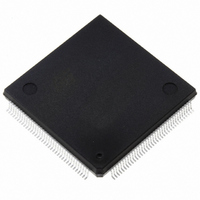ST10F272Z2Q3 STMicroelectronics, ST10F272Z2Q3 Datasheet - Page 82

ST10F272Z2Q3
Manufacturer Part Number
ST10F272Z2Q3
Description
MCU 16BIT 256KB FLASH 144-PQFP
Manufacturer
STMicroelectronics
Series
ST10r
Datasheet
1.ST10F272Z2Q3.pdf
(189 pages)
Specifications of ST10F272Z2Q3
Core Processor
ST10
Core Size
16-Bit
Speed
64MHz
Connectivity
ASC, CAN, EBI/EMI, I²C, SSC, UART/USART
Peripherals
POR, PWM, WDT
Number Of I /o
111
Program Memory Size
256KB (256K x 8)
Program Memory Type
FLASH
Ram Size
20K x 8
Voltage - Supply (vcc/vdd)
4.5 V ~ 5.5 V
Data Converters
A/D 24x10b
Oscillator Type
Internal
Operating Temperature
-40°C ~ 125°C
Package / Case
144-QFP
Lead Free Status / RoHS Status
Lead free / RoHS Compliant
Eeprom Size
-
Other names
497-5579
Available stocks
Company
Part Number
Manufacturer
Quantity
Price
Company:
Part Number:
ST10F272Z2Q3
Manufacturer:
E-CMOS
Quantity:
10 000
Company:
Part Number:
ST10F272Z2Q3
Manufacturer:
STMicroelectronics
Quantity:
10 000
System reset
20.2
Note:
Note:
82/189
Asynchronous reset
An asynchronous reset is triggered when RSTIN pin is pulled low while RPD pin is at low
level. Then the ST10F272Z2 is immediately (after the input filter delay) forced in reset
default state. It pulls low RSTOUT pin, it cancels pending internal hold states if any, it aborts
all internal/external bus cycles, it switches buses (data, address and control signals) and I/O
pin drivers to high-impedance, it pulls high Port0 pins.
If an asynchronous reset occurs during a read or write phase in internal memories, the
content of the memory itself could be corrupted: to avoid this, synchronous reset usage is
strongly recommended.
Power-on reset
The asynchronous reset must be used during the power-on of the device. Depending
on crystal or resonator frequency, the on-chip oscillator needs about 1ms to 10ms to
stabilize (Refer to Electrical Characteristics Section), with an already stable V
of the ST10F272Z2 does not need a stabilized clock signal to detect an asynchronous reset,
so it is suitable for power-on conditions. To ensure a proper reset sequence, the RSTIN pin
and the RPD pin must be held at low level until the device clock signal is stabilized and the
system configuration value on Port0 is settled.
At Power-on it is important to respect some additional constraints introduced by the start-up
phase of the different embedded modules.
In particular the on-chip voltage regulator needs at least 1ms to stabilize the internal 1.8V
for the core logic: this time is computed from when the external reference (V
stable (inside specification range, that is at least 4.5 V). This is a constraint for the
application hardware (external voltage regulator): the RSTIN pin assertion shall be extended
to guarantee the voltage regulator stabilization.
A second constraint is imposed by the embedded FLASH. When booting from internal
memory, starting from RSTIN releasing, it needs a maximum of 1ms for its initialization:
before that, the internal reset (RST signal) is not released, so the CPU does not start code
execution in internal memory.
This is not true if external memory is used (pin EA held low during reset phase). In this case,
once RSTIN pin is released, and after few CPU clock (Filter delay plus 3...8 TCL), the
internal reset signal RST is released as well, so the code execution can start immediately
after. Obviously, an eventual access to the data in internal Flash is forbidden before its
initialization phase is completed: an eventual access during starting phase will return FFFFh
(just at the beginning), while later 009Bh (an illegal opcode trap can be generated).
At Power-on, the RSTIN pin shall be tied low for a minimum time that includes also the start-
up time of the main oscillator (t
synchronization time (t
RSTIN pin could be released before the main oscillator and PLL are stable to recover some
time in the start-up phase (Flash initialization only needs stable V
stable system clock since an internal dedicated oscillator is used).
Warning:
It is recommended to provide the external hardware with a
current limitation circuitry. This is necessary to avoid
permanent damages of the device during the power-on
transient, when the capacitance on V
the on-chip voltage regulator functionality 10 nF are
PSUP
= 200µs): this means that if the internal FLASH is used, the
STUP
= 1ms for resonator, 10ms for crystal) and PLL
18
pin is charged. For
18
, but does not need
DD
DD
ST10F272Z2
) becomes
. The logic













